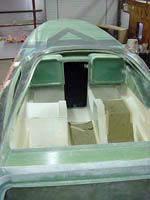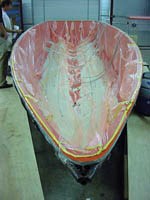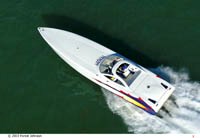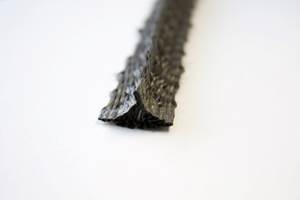Racing Veteran Fine-tunes Classic Competitive Concept
Hand layup of reinforced epoxy yields hybrid luxury powerboat/offshore racer.
Every boatbuilder has a unique concept, and a unique way of realizing it. Craig Barrie, president of Dragon Powerboats (Ft. Lauderdale, Fla., U.S.A.), is no exception. A former world and national offshore, or open ocean, powerboat racing champion, he envisioned a new type of hybrid offshore racer/luxury cruiser five years ago and assembled a strong team to help design and fabricate it.
"I wanted a boat based on racing technology, but with consumer comfort features and proven durability," states Barrie. "I wanted something different, and I knew there was a better way to build the type of boat I wanted."
At 8.6 ft wide and 39 ft long, the Dragon 39's overall look is typical of the exaggerated and elongated "cigarette" style used to race in open seas. Beneath the styling, however, is a highly-engineered composite structure made with fiberglass-, aramid- and carbon-reinforced epoxy for improved stiffness, durability and lighter weight than competing designs made with polyester or vinyl ester. The exterior is painted, rather than gel-coated, which saves additional weight. The lighter weight means that ballast can be strategically placed to optimize the boat's center of gravity for racing events.
Structural engineer Mark Bishop, now with Farr Yacht Design (Annapolis, Md., U.S.A.), developed the structural and laminate design, while New Zealand designer Philip Mead worked with Barrie on the hull shape, a "stepped" hull, meaning it has two changes in elevation along the profile of the keel, from front to back. Stepped hulls cause the bow of the boat to ride "high," and the water flow actually separates from the forward part of the hull and reattachs further aft, thus lowering drag. NDL Wright Inc. (Ft. Lauderdale, Fla., U.S.A.) was retained to build plugs, molds and the boats themselves. The first copy was finished less than a year ago, and four additional boats are currently in production.
Epoxy: A No-Brainer
"Epoxy may cost more than polyester or vinyl ester," says Bishop, "but you use less, so the overall laminate weighs less. It's the cheapest hull weight-saving technique you can employ."
While straight weight savings wasn't the main design driver at the beginning, Barrie's fundamental requirement was a vessel that could run for years at high speed in offshore conditions without suffering any hull damage, using off-the-shelf, readily available gasoline-powered Mercury stern drive engines. To meet those guidelines, says Bishop, the design needed to be fairly conservative, for durability, yet still stiff and lightweight, to meet racing requirements. An epoxy resin-based laminate was selected as the best solution.
Bishop notes a few of the points favoring epoxy. For wet laminating, it is much better at encapsulating and bonding with the fibers and has better ply-to-ply adhesion than polyester or vinyl ester. Because it develops a higher degree of crosslinking, it has better flex characteristics and fatigue strength, despite vinyl ester's better elongation. It also exhibits superior secondary bond strength, meaning parts or plies that are bonded to a cured laminate adhere better. Epoxy uses no styrene so EPA-regulated emissions are avoided. And, says builder Doug Wright, working time is longer and more tailorable -- by mixing various hardeners, it's possible to create a system with nearly 14 hours of out time.
Bishop based the design on the Det Norske Veritas (DNV) "High Speed and Light Craft" guideline, to determine local hull pressures (also see "The Basics of Boat Design," this issue, p. 24). He assumed 5G vertical acceleration for the typical case, and 7G for an atypical case. Typical factors of safety ranged from 3 to 4. Because of the Dragon 39's small size, local pressure loads predominate. "You determine if a hull panel between two stringers -- a small 'local' area -- is strong enough to withstand a projected load," he explains. "If you design to local loads, the overall boat generally will be strong enough for any global loads, such as overall hull bending or twisting, although a specific analysis of this was also undertaken."
Bishop's complex and highly selective laminate design involves cored sandwich laminates, with different types and grades of core in different areas of the vessel. The hull bottom incorporates 25-mm/1-inch-thick AIREX R63-140 linear PVC closed-cell foam core from Alcan Baltek Corp. (Northvale, N.J., U.S.A.), selected for its extremely high shear elongation (80 percent), ductility and high peel resistance. According to Bishop, the core's elasticity prevents fracture, which can propagate and eventually lead to skin delamination under slamming loads. Based on the known tendency for offshore boats to break near bulkheads, he added core pads beneath the three longitudinal girders that pass under the boat's bulkheads to gain additional panel strength in those locations. He also added unidirectional carbon fiber to the girder tops for added stiffness.
The outer skin on the bottom hull includes a single ply of woven glass cloth from SAERTEX USA LLC (Mooresville, N.C., U.S.A.), followed by a E-glass triaxial fabric, oriented with the zero axis parallel to the boat's beam (width). The third ply, against the core, is an intraply aramid/E-glass woven hybrid supplied by JB Martin (St. Jean Syr Richelieu, Quebec, Canada). The E-glass improves aramid's compression strength, while the aramid contributes elongation and impact resistance to the hull. The inner skin mirrors the outer, but without the glass cloth.
For the hull's sides, the core is an Alcan Baltek HEREX C70-75 foam core. Skins are a combination of the same triaxial E-glass and a biaxial (+/- 45) E-glass, both oriented with the zero axis running vertically up the sides. Says Bishop, "A boat is basically a beam. The hull sides are the shear webs, and they can carry high shear loads when, for example, the boat lands hard on the bow and stern with the midsection unsupported."
For the elongated deck, Bishop specified AIREX C70 foam core with triaxial E-glass fabric skins, supplemented with 300 mm/12-inch wide unidirectional carbon fiber. The carbon reinforcement forms an "A"-shape in the deck's outer skin on the foredeck, which is needed, says Bishop,
because there are no internal deck frames within the bow and the strength is all in the shell. More carbon fiber strips provide stiffness and support at the transition between the wide foredeck and the narrow side deck, where loads tend to concentrate, as well as around the canopy and the engine hatch.
Manufacturing Details Ensure Performance
Wright created male plugs for the hull, the deck, the inner liner (which incorporates integrated seats), the engine cover and the dashboard by bonding 2.4-lb density closed cell polystyrene foam material from The Dow Chemical Co. (Midland, Mich., U.S.A.) to steel and plywood shapes. The foam was CNC machined with a 5-axis, overhead bridge-mounted robotic router from PaR Systems Inc. (Shoreview, Minn., U.S.A.). Once the plug shapes were cut, they were laminated with a heavy ply of fiberglass wet out with epoxy, then covered with a sprayable polyester putty from ITW SprayCore (Cincinnati, Ohio, U.S.A.), milled, sanded, primed and polished.
Wright's crew then fabricated female molds on the plugs, starting with two coats of a tooling gel coat from Cook Composites & Polymers (North Kansas City, Mo., U.S.A.), followed by a skin coat of chopped strand mat wet out with vinyl ester resin and a thin layer of SprayCore as a print barrier. The mold thickness was built up with approximately five plies of chopped strand mat. Support structures were formed by bending 38 mm/1.5-inch round pipe and laminating the pipe onto the mold exterior with fiberglass, creating pipework "baskets" around each mold. Steel wheels were welded on for mobility.
To mold the boat parts, Wright ensured optimum fiber/resin ratio by using an impregnation machine, essentially an open bath with two adjustable rollers, obtained from marine design firm High Modulus (Auckland, New Zealand). Each reinforcement ply was weighed dry, then wet out with SP Systems' (Isle of Wight, U.K.) Ampreg 22 epoxy and run through the rollers set to a certain speed to squeeze out excess resin. The wetted ply was weighed on a digital scale; if too heavy (i.e., too much resin), the ply was run through the rollers a second time, to obtain precisely the right resin-to-fiber ratio (no more than 35 percent resin) before layup in the molds. This approach ensured that design weight targets were met and eliminated hand rolling in the mold for a much cleaner workspace.
Wright does not favor gel coats, and chose to paint the hull. He used only a thin, in-mold epoxy primer/gel during layup. "I've seen polyester gel coats actually lose adhesion on offshore boats and peel off. By going with paint, we saved at least 90 kg/200 lb."
The parts were vacuum bagged, then cured at room temperature. A post-cure was required, to ensure complete crosslinking and full properties. Parts were placed in an oven and gradually ramped up to 60°C/140°F -- essentially the limit for the foam cores -- and back down again over a 24-hour period. Final cured skin thickness was about 2.5 mm/0.1 inch, and at 3,900 kg/8,600 lb the finished boat was within a few pounds of the design weight estimate, says Barrie.
Carefree Performance
The drop-in Mercury engines range from 500 to 1,000 hp depending on customer requirements, and speeds close to 100 mph are possible with the 525-hp versions. For racing enthusiasts, the boat can compete in F-2 or Super Vee classes. Barrie notes that the boat is 136 kg/300 lb short of the F-2 weight requirement, leaving significant room for owners who race in that class to adjust the boat's center of gravity with ballast. Bells and whistles include adjustable Recaro seats, wraparound stainless steel-framed wind screen, and 400-watt stereo with six speakers.
"My goal is to produce and sell 12 boats per year," says Barrie. "I'm so confident in the design and construction, that we offer a two-year hull warranty." Cost is about $385,000 with the 525-hp engine option. Concludes Bishop, "The Dragon 39 is a high-technology boat for its market segment."
Related Content
Biteam introduces 3D Noodle International AB spin-off for 3D fabric noodles
Biteam 3D’s third spin-off implements its proprietary 3D weaving technology to produce a variety of carbon, ceramic and other fiber 3D fabric noodle preforms.
Read MorePEEK vs. PEKK vs. PAEK and continuous compression molding
Suppliers of thermoplastics and carbon fiber chime in regarding PEEK vs. PEKK, and now PAEK, as well as in-situ consolidation — the supply chain for thermoplastic tape composites continues to evolve.
Read MoreMaterials & Processes: Fabrication methods
There are numerous methods for fabricating composite components. Selection of a method for a particular part, therefore, will depend on the materials, the part design and end-use or application. Here's a guide to selection.
Read MoreComposite resins price change report
CW’s running summary of resin price change announcements from major material suppliers that serve the composites manufacturing industry.
Read MoreRead Next
From the CW Archives: The tale of the thermoplastic cryotank
In 2006, guest columnist Bob Hartunian related the story of his efforts two decades prior, while at McDonnell Douglas, to develop a thermoplastic composite crytank for hydrogen storage. He learned a lot of lessons.
Read MoreCW’s 2024 Top Shops survey offers new approach to benchmarking
Respondents that complete the survey by April 30, 2024, have the chance to be recognized as an honoree.
Read MoreComposites end markets: Energy (2024)
Composites are used widely in oil/gas, wind and other renewable energy applications. Despite market challenges, growth potential and innovation for composites continue.
Read More


















.jpg;maxWidth=300;quality=90)













